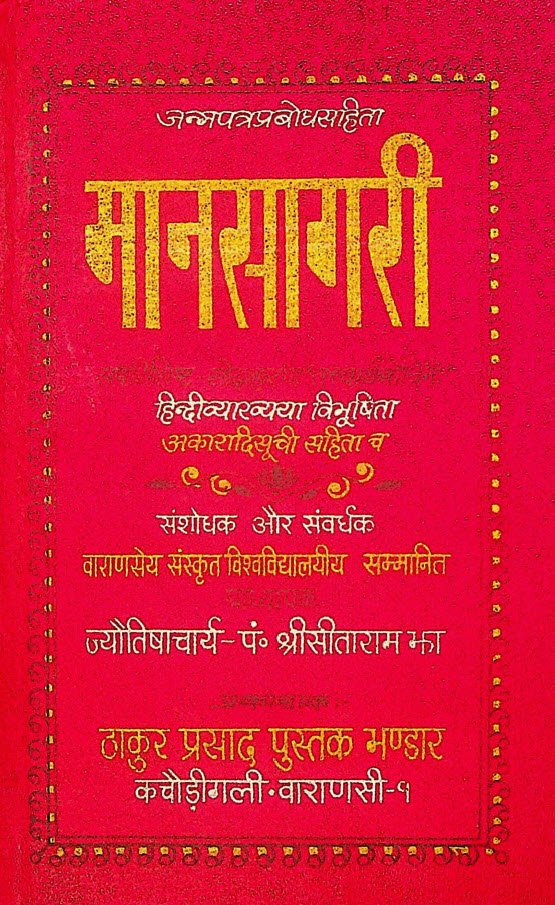Author: Janardan Harji
About the Translator: Various renowned authors have written Hindi commentary on the book
Mansagari : मानसागरी
Manasagari is a classical text on Hindu astrology (Jyotisha), attributed to Janardan Harji. This work is considered an important part of the astrological canon, offering detailed insights into various aspects of astrology, including predictive techniques, horoscopy, and the interpretation of planetary influences.
Overview of Manasagari
- Authorship and Composition:
- The text is attributed to Janardan Harji, but we don’t know much about him. It is said that he was born in Gujrat. He used to be a renowned astrologer of his time.
- It is believed to have been composed several centuries ago, drawing on earlier astrological traditions and knowledge.
- Structure:
- Manasagari is typically divided into five chapters, each addressing different aspects of astrology.
- The chapters cover a range of topics, including the basics of astrology, planetary positions, houses, yogas (planetary combinations), and predictive methods.
- Content and Themes:
- Fundamental Principles: The text outlines the basic principles of astrology, including the significance of the twelve zodiac signs, the nine planets (Navagrahas), and the twelve houses (Bhavas) in a horoscope.
- Planetary Influences: Detailed descriptions of the effects of planets in various signs and houses, including their benefic and malefic influences.
- Yogas and Combinations: Explanation of various yogas (planetary combinations) and their impact on an individual’s life, including wealth, health, relationships, and career.
- Predictive Techniques: Methods for predicting future events and trends based on planetary positions and transits, including dasha systems (planetary periods). However, it doesn’t say much about ashtakavarga (a unique system of prediction).
Key Sections and Themes
- Fundamentals of Astrology:
- Introduction to the twelve zodiac signs, their characteristics, and how they influence an individual’s personality and life events.
- Overview of the nine planets (Sun, Moon, Mars, Mercury, Jupiter, Venus, Saturn, Rahu, and Ketu) and their roles in astrology.
- Houses and Their Significance:
- Detailed descriptions of the twelve houses (Bhavas) in a horoscope, each representing different aspects of life such as self, wealth, siblings, parents, children, health, marriage, death, fortune, profession, gains, and losses.
- Analysis of the impact of planets when they occupy or aspect different houses.
- Yogas and Special Combinations:
- Explanation of various yogas or planetary combinations that have significant effects on an individual’s life, such as Raja Yoga (indicating power and success), Dhana Yoga (indicating wealth), and Arishta Yoga (indicating challenges or misfortune).
- How to identify these yogas in a horoscope and interpret their implications.
I have expounded one Sinhasan Yoga from Manasagari in this video:
4. Predictive Astrology:
- Methods for predicting future events based on planetary positions and movements.
- Explanation of Dasha systems, particularly the Vimshottari Dasha, which is one of the most widely used techniques for timing events in Vedic astrology.
Significance and Influence
- Astrological Scholarship:
- Manasagari is considered a valuable resource for both novice and experienced astrologers, offering comprehensive insights into the principles and practices of Vedic astrology.
- Its detailed analysis of planetary influences and predictive techniques makes it a foundational text in the study of Jyotisha.
- Cultural and Religious Context:
- The text reflects the integration of astrology into the broader cultural and religious framework of Hindu society, where astrology plays a significant role in various life decisions and rituals.
- It underscores the belief in the cosmic order and the influence of celestial bodies on human life.
- Practical Application:
- Manasagari provides practical tools for astrological analysis and prediction, helping individuals understand their horoscopes and make informed decisions about their lives.
- Its emphasis on yogas and predictive techniques offers valuable guidance for interpreting complex horoscopes.
Conclusion
Manasagari stands as a significant text in the field of Hindu astrology, offering a comprehensive and systematic approach to understanding and interpreting horoscopes. Attributed to the sage Manasagari, it covers a wide range of astrological principles and techniques, providing valuable insights into the influence of planets and their combinations on various aspects of life. As a key resource for astrologers, it continues to play an important role in the practice and study of Jyotisha, helping individuals navigate the complexities of their destinies through the lens of celestial wisdom.
Mansagari has numerous yogas and Raja Yogas and their effects. It has numerous unique principles that have withstood with the passage and test of time. The bhavesh faladhyay where the position of lord of various houses is of particular importance.
Please also visit our blog JyotishRahasya for authentic scripture-based Kundali vishleshan (horoscope analysis) and kundli matchmaking. To watch educational videos based on Brihat Parashara Hora Shastra and other scriptures, also subscribe to our Jyotish Rahasya Youtube Channel.
Translations and Commentaries:
There are quite a few Hindi commentaries available on this popular book:
- Mansagari Tr. By Dr. Ramchandra Pandey
- Mansagari Paddhati Tr. By Parmanand Shastri
- Mansagari Tr. By Vanshidhar (Khemraj Shri Krishndas Prakashan)
- Mansagari Tr. By Pt. Shri Sita Ram Jha (Thakur Prasad Varanasi)
Mansagari| मानसागरी
| लेखक : | Janardan Harji| जनार्दन हरजी |
|---|---|
| Book Language | हिंदी | Hindi |
| पुस्तक का साइज़ : |
|
| कुल पृष्ठ : |
|
| श्रेणी : | धार्मिक / Religious, साहित्य / Literature, हिंदू – Hinduism |
Mansagari Tr. By Dr. Ramchandra Pandey (23 MB)
Mansagari Paddhati Tr. By Parmanand Shastri (30 MB)
Mansagari Tr. By Vanshidhar (Khemraj Shri Krishndas Prakashan) (210 MB)
Mansagari Tr. By Pt. Shri Sita Ram Jha (Thakur Prasad Varanasi) (176 MB)






